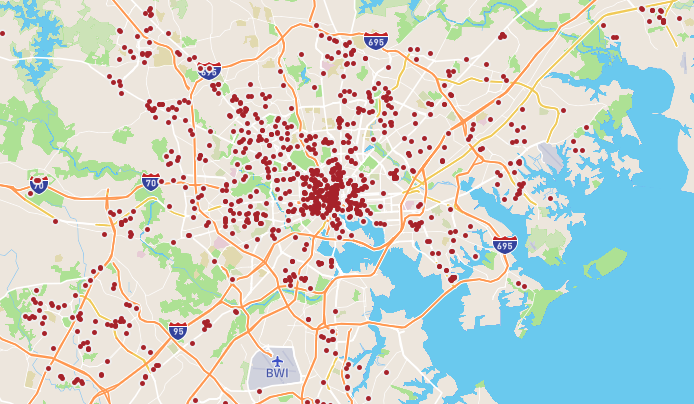This map shows where people can’t get evicted during COVID-19

Screenshot of map showing eviction-exempt properties across the country. by National Low Income Housing Coalition.
As the unemployment rate surges in light of the novel coronavirus crisis, renters are under an even greater threat of eviction. One silver lining is that the recently passed CARES Act provides a moratorium on evictions for many residents of federally subsidized housing.
DC and Maryland have also instituted regional restrictions on evictions during the COVID-19 crisis. Virginia has limited evictions, but beginning this week, some eviction cases will be allowed to move forward in court.
The moratorium under the CARES Act covers public housing, Section 8 housing, low-income housing tax credit properties, properties with federally-backed mortgage loans, and several other programs. This interactive map, from the National Low Income Housing Coalition (NLIHC), shows a picture of units across the country where evictions are suspended through the federal moratorium.
NLIHC caveats that the maps only show multifamily units, single family rentals, small multifamily units. Additionally, not all of the government agencies with affected properties have reported data to NLIHC.
Although there are eviction-exempt properties across the District, the largest concentrations are in central DC including neighborhoods such as Mount Pleasant, Columbia Heights and Shaw, and neighborhoods in Ward 8 such as Anacostia, Congress Heights, and Washington Highlands.
Screenshot from map showing concentrations of eviction-exempt properties in Mid City DC and east of the Anacostia River. 
In the Baltimore region, most of the properties with eviction exemptions are within the 695 Beltway, and specifically in Baltimore City.
Screenshot of map showing that properties with eviction exemptions within the 695 Beltway. 
Richmond’s exempt properties are also heavily concentrated in the city’s center.
Screenshot of map showing Richmond’s exempt properties are heavily concentrated in the city’s center. 
Although the purpose of this map is to illustrate where renters have additional rights during the crisis, it inadvertently highlights the uneven distribution of multifamily units. While renters in federally subsidized apartments might proliferate in cities, this does not necessarily match the increasing suburbanization of poverty across the country.
What else did you notice about these maps?
